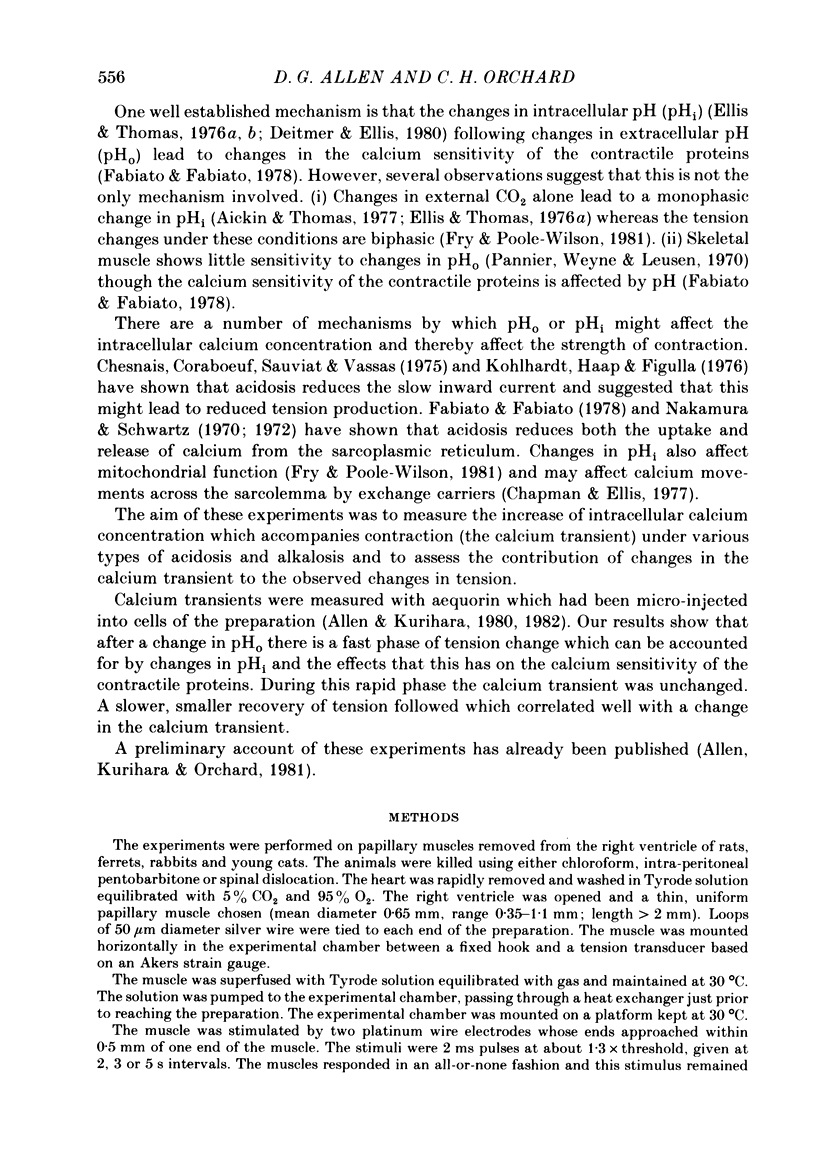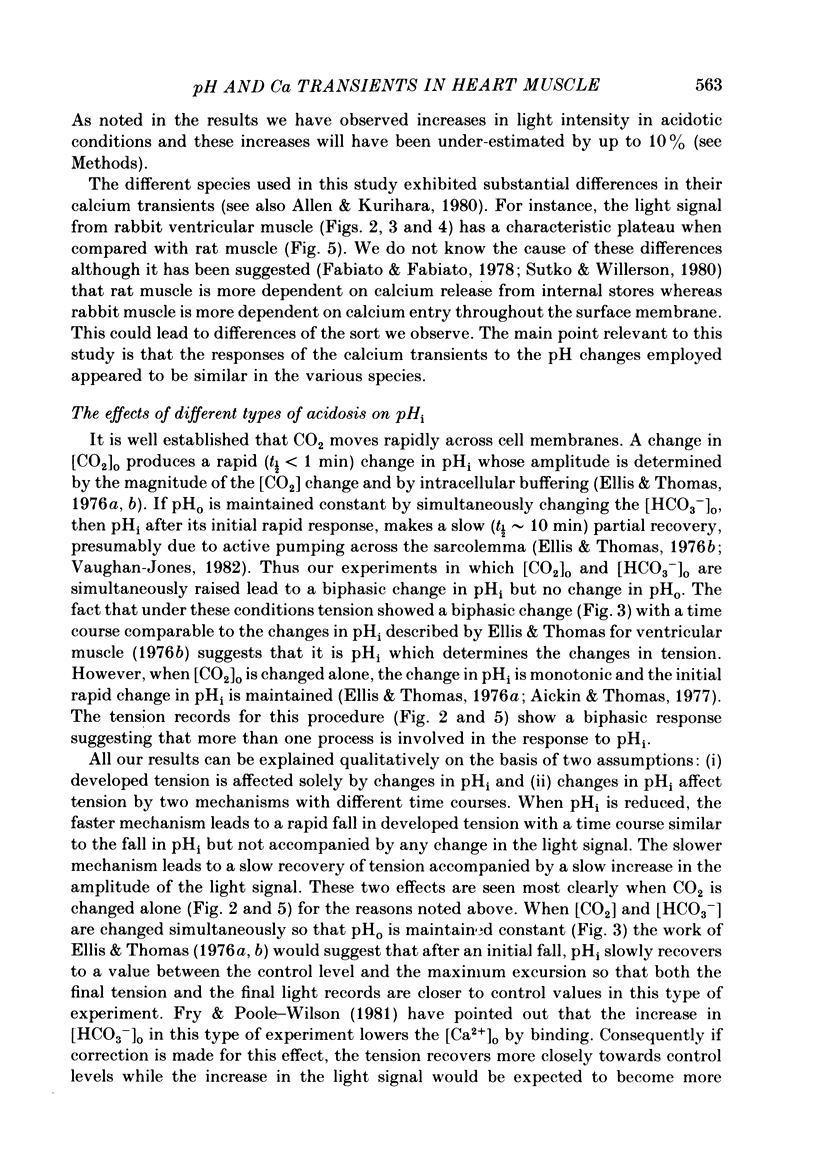Abstract
The calcium-sensitive photoprotein aequorin was micro-injected into cells of rat, ferret, rabbit and cat papillary muscles. Aequorin light emission is a function of free intracellular calcium concentration. The changes in intracellular calcium concentration [( Ca2+]i) and tension accompanying changes of pH have been studied. When the solution perfusing the papillary muscle was changed from Tyrode solution equilibrated with 5% CO2 to Tyrode solution equilibrated with 15% CO2, developed tension showed a rapid fall followed by a slower rise to a steady state which was less than the control. However the calcium transient associated with each contraction increased monophasically to a new steady state. When the external pH was held constant during exposure to 15% CO2 (by increasing the [HCO3-]), the initial fall of tension was reduced and the slow recovery of tension was greater than when CO2 alone was changed. The amplitude of the calcium transient increased monophasically to a new steady state which was greater than control, but less than when [CO2] alone was increased. If [HCO3-] was decreased while maintaining [CO2] at 5%, there was a slow monophasic decline in developed tension, and a small increase in peak light. Alkaloses produced by changing the [HCO3-]/[CO2] ratio produced similar results but the changes observed were in the opposite direction to those described above. The effects of changes of pHo can be explained if pHi affects tension by two mechanisms. The first mechanism, which is responsible for the rapid change in tension, is not associated with a change in [Ca2+]i. The second mechanism leads to a slower and smaller change in tension, in the opposite direction to the first, and is due to a change in the intracellular calcium transient.
Full text
PDF












Images in this article
Selected References
These references are in PubMed. This may not be the complete list of references from this article.
- Allen D. G., Blinks J. R., Prendergast F. G. Aequorin luminescence: relation of light emission to calcium concentration--a calcium-independent component. Science. 1977 Mar 11;195(4282):996–998. doi: 10.1126/science.841325. [DOI] [PubMed] [Google Scholar]
- Allen D. G., Kurihara S. Calcium transients in mammalian ventricular muscle. Eur Heart J. 1980;Suppl A:5–15. doi: 10.1093/eurheartj/1.suppl_1.5. [DOI] [PubMed] [Google Scholar]
- Allen D. G., Kurihara S. The effects of muscle length on intracellular calcium transients in mammalian cardiac muscle. J Physiol. 1982 Jun;327:79–94. doi: 10.1113/jphysiol.1982.sp014221. [DOI] [PMC free article] [PubMed] [Google Scholar]
- Bers D. M., Ellis D. Intracellular calcium and sodium activity in sheep heart Purkinje fibres. Effect of changes of external sodium and intracellular pH. Pflugers Arch. 1982 Apr;393(2):171–178. doi: 10.1007/BF00582941. [DOI] [PubMed] [Google Scholar]
- Blinks J. R., Prendergast F. G., Allen D. G. Photoproteins as biological calcium indicators. Pharmacol Rev. 1976 Mar;28(1):1–93. [PubMed] [Google Scholar]
- Chapman R. A., Ellis D. The existence of a Ca2+ for H+ exchange across the sarcolemma of frog cardiac muscle cells [proceedings]. J Physiol. 1977 Feb;265(1):19P–20P. [PubMed] [Google Scholar]
- Chesnais J. M., Coraboeuf E., Sauviat M. P., Vassas J. M. Sensitivity to H, Li and Mg ions of the slow inward sodium current in frog atrial fibres. J Mol Cell Cardiol. 1975 Sep;7(9):627–642. doi: 10.1016/0022-2828(75)90140-6. [DOI] [PubMed] [Google Scholar]
- Deitmer J. W., Ellis D. Interactions between the regulation of the intracellular pH and sodium activity of sheep cardiac Purkinje fibres. J Physiol. 1980 Jul;304:471–488. doi: 10.1113/jphysiol.1980.sp013337. [DOI] [PMC free article] [PubMed] [Google Scholar]
- Ellis D., Thomas R. C. Direct measurement of the intracellular pH of mammalian cardiac muscle. J Physiol. 1976 Nov;262(3):755–771. doi: 10.1113/jphysiol.1976.sp011619. [DOI] [PMC free article] [PubMed] [Google Scholar]
- Ellis D., Thomas R. C. Microelectrode measurement of the intracellular pH of mammalian heart cells. Nature. 1976 Jul 15;262(5565):224–225. doi: 10.1038/262224a0. [DOI] [PubMed] [Google Scholar]
- Fabiato A., Fabiato F. Calcium-induced release of calcium from the sarcoplasmic reticulum of skinned cells from adult human, dog, cat, rabbit, rat, and frog hearts and from fetal and new-born rat ventricles. Ann N Y Acad Sci. 1978 Apr 28;307:491–522. doi: 10.1111/j.1749-6632.1978.tb41979.x. [DOI] [PubMed] [Google Scholar]
- Fabiato A., Fabiato F. Effects of pH on the myofilaments and the sarcoplasmic reticulum of skinned cells from cardiace and skeletal muscles. J Physiol. 1978 Mar;276:233–255. doi: 10.1113/jphysiol.1978.sp012231. [DOI] [PMC free article] [PubMed] [Google Scholar]
- Fry C. H., Poole-Wilson P. A. Effects of acid-base changes on excitation--contraction coupling in guinea-pig and rabbit cardiac ventricular muscle. J Physiol. 1981;313:141–160. doi: 10.1113/jphysiol.1981.sp013655. [DOI] [PMC free article] [PubMed] [Google Scholar]
- Fuchs F., Reddy Y., Briggs F. N. The interaction of cations with the calcium-binding site of troponin. Biochim Biophys Acta. 1970 Nov 17;221(2):407–409. doi: 10.1016/0005-2795(70)90290-4. [DOI] [PubMed] [Google Scholar]
- Gaskell W. H. On the Tonicity of the Heart and Blood Vessels. J Physiol. 1880 Aug;3(1):48–92.16. doi: 10.1113/jphysiol.1880.sp000083. [DOI] [PMC free article] [PubMed] [Google Scholar]
- Godt R. E. A simple electrostatic model can explain the effect of pH upon the force-pCa relation of skinned frog skeletal muscle fibers. Biophys J. 1981 Aug;35(2):385–392. doi: 10.1016/S0006-3495(81)84797-2. [DOI] [PMC free article] [PubMed] [Google Scholar]
- Katz A. M., Hecht H. H. Editorial: the early "pump" failure of the ischemic heart. Am J Med. 1969 Oct;47(4):497–502. doi: 10.1016/0002-9343(69)90180-6. [DOI] [PubMed] [Google Scholar]
- Kohama K. Role of the high affinity Ca binding sites of cardiac and fast skeletal troponins. J Biochem. 1980 Aug;88(2):591–599. doi: 10.1093/oxfordjournals.jbchem.a133007. [DOI] [PubMed] [Google Scholar]
- Kohlhardt M., Haap K., Figulla H. R. Influence of low extracellular pH upon the Ca inward current and isometric contractile force in mammalian ventricular myocardium. Pflugers Arch. 1976 Oct 15;366(1):31–38. doi: 10.1007/BF02486557. [DOI] [PubMed] [Google Scholar]
- Micro-electrode measurement of the intracellular pH and buffering power of mouse soleus muscle fibres. J Physiol. 1977 Jun;267(3):791–810. doi: 10.1113/jphysiol.1977.sp011838. [DOI] [PMC free article] [PubMed] [Google Scholar]
- Nakamaru Y., Schwartz A. Possible control of intracellular calcium metabolism by [H+]: sarcoplasmic reticulum of skeletal and cardiac muscle. Biochem Biophys Res Commun. 1970 Nov 25;41(4):830–836. doi: 10.1016/0006-291x(70)90157-9. [DOI] [PubMed] [Google Scholar]
- Nakamaru Y., Schwartz A. The influence of hydrogen ion concentration on calcium binding and release by skeletal muscle sarcoplasmic reticulum. J Gen Physiol. 1972 Jan;59(1):22–32. doi: 10.1085/jgp.59.1.22. [DOI] [PMC free article] [PubMed] [Google Scholar]
- Pannier J. L., Weyne J., Leusen I. Effects of PCO2, bicarbonate and lactate on the isometric contractions of isolated soleus muscle of the rat. Pflugers Arch. 1970;320(2):120–132. doi: 10.1007/BF00588547. [DOI] [PubMed] [Google Scholar]
- Poole-Wilson P. A. Measurement of myocardial intracellular pH in pathological states. J Mol Cell Cardiol. 1978 Jun;10(6):511–526. doi: 10.1016/0022-2828(78)90010-x. [DOI] [PubMed] [Google Scholar]
- Roos A., Boron W. F. Intracellular pH. Physiol Rev. 1981 Apr;61(2):296–434. doi: 10.1152/physrev.1981.61.2.296. [DOI] [PubMed] [Google Scholar]
- Sutko J. L., Willerson J. T. Ryanodine alteration of the contractile state of rat ventricular myocardium. Comparison with dog, cat, and rabbit ventricular tissues. Circ Res. 1980 Mar;46(3):332–343. doi: 10.1161/01.res.46.3.332. [DOI] [PubMed] [Google Scholar]



